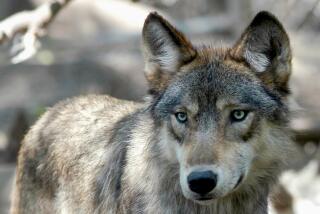But Pennsylvania Farmers Aren’t Amused : Sightseers Take Delight in Thriving Elk Herd
- Share via
EMPORIUM, Pa. — Norm Erickson first saw a wild elk 40 years ago, and he is one of a legion who treasure memories of sighting one of the majestic members of the only free-roaming elk herd east of Michigan.
“It’s a real thrill to see a big old bull. I love to hear them bugle. They really put on a show,” said Erickson, 71, who retired in 1980 after 34 years as a game warden.
Sightseers by the thousands flock to a 200-square-mile area in Elk and Cameron counties in north-central Pennsylvania. They sometimes block rural roads to admire a herd of 140 elk, which are protected by law.
A nature-lover’s rapture can be a farmer’s nuisance, however.
Only 40% of the elk range is on public land, and farmers say marauding elk eat or trample corn crops, bulldoze barbed-wire fences and harass or kill domestic livestock.
“They’re nice to see, but I can’t afford to feed them. They’re eating better than my cows,” said dairy farmer David Wolfe of St. Marys.
‘Good for Nothing’
“The only thing they’re good for is to look at,” said Homer Grimm, a farmer in nearby Emporium. “They devastate the crops. You can’t hunt them. They’re valueless. They’re good for nothing.”
The Pennsylvania Game Commission is caught in the middle. Some say the commission is doing too little to keep the elk off private lands and out of trouble. Others say too much revenue from hunting license fees is being spent on an animal that can’t be hunted.
“We have to be the voice of wildlife,” said Rawland Cogan, a wildlife technician with the Game Commission. “There’s lots of farmers who’d like to see the doggone things eliminated. Just because we don’t hunt bald eagles doesn’t mean we should get rid of them.”
The elk is a voracious eater. A big bull weighs 800 pounds and consumes 22 pounds of forage a day--six times more than the average-sized (125-pound) white-tailed deer. As many as 40 elk at a time may graze in a field, and some farmers say they are left with only a fraction of what they should harvest.
“It’s like turning loose a herd of cows. Between eating it and trampling it, they can go right through a cornfield. They demolish trees, fences, shrubbery--everything,” said farmer Vincent Wolfe.
Board Hears Complaints
The Game Commission is in the final year of a 5-year plan with the Bureau of Forestry to keep elk out of farmers’ hair. A nine-member elk management committee hears advice from farmers, sportsmen and environmentalists.
Researchers at Penn State University have developed a five-strand electric fence that is elk-proof. The state offers free wire, posts and power pack, but no farmer has taken the offer. Farm owners say they don’t want to supply the labor or maintain the fences.
Meanwhile, plots of leafy plants and grasses that appeal to elk have been cultivated on state lands and there are plans next year to plant alfalfa, which elk love.
Foresters have cleared sections of woods to promote new growth of aspen and other trees that elk find succulent. Salt blocks have been put out.
Yet the elk seem to prefer farm-grown corn, oats, wheat, barley and hay.
“Would you rather have a bowl of spinach or a bowl of ice cream? That’s the difference between chewing browse and feasting on corn,” said game protector Joe Carlos of Cameron County.
Intruders May Be Shot
The Game Commission doesn’t pay for elk damage so, in a sort of backwoods justice, the game law allows farmers to kill elk that damage their crops. The farmer gets the meat; the state gets the hide and the head. In the last 12 years, farmers have killed 45 of the animals.
“The only legal recourse is to shoot the offending animals,” said Bill Drake, a Game Commission biologist and elk expert.
Such kills have political drawbacks. Farmers who shoot elk say they have been harassed by environmentalists who have slashed tractor tires and threatened to burn barns.
“We’re the bad guys. And what we get from an elk doesn’t cover the value of the crops we lose,” said farmer William Lyons, who has shot three elk in six years.
Elk were native to Pennsylvania but were eradicated shortly after the Civil War. They rank behind moose as the largest members of the deer family.
The last indigenous elk was thought to have been shot in 1867 near the headwaters of the Clarion River.
Population Growth
Nearly 50 years later, the state imported a few elk by train from Yellowstone National Park. From 1913 to 1926, 177 animals were stocked. Crop-damage complaints were heard the year the first Rocky Mountain elk arrived.
Limited hunting was allowed from 1923 until 1931, but the elk were left alone until game managers began counting them in 1971. They now use helicopters and ground trackers to take a herd census every January.
From a low of 38 in 1974, the herd has grown to 140--the largest since the census began.
Almost every year an elk is mistaken for a deer and shot, and 52 have been killed by poachers or careless hunters in the last 12 years. Killing an elk illegally carries an $800 fine. This year, the Elk County Federation of Sportsmen offered a $200 reward for tips that lead to arrests of poachers.
More to Read
Sign up for The Wild
We’ll help you find the best places to hike, bike and run, as well as the perfect silent spots for meditation and yoga.
You may occasionally receive promotional content from the Los Angeles Times.






